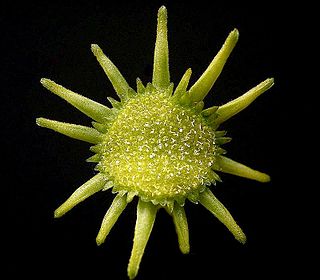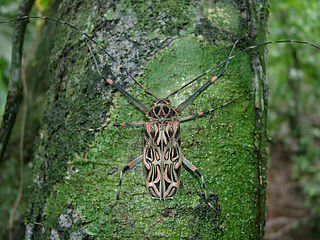
Artocarpus integer, commonly known as chempedak or cempedak, is a species of tree in the family Moraceae, in the same genus as breadfruit and jackfruit. It is native to Southeast Asia. Cempedak is an important crop in Malaysia and is also popularly cultivated in southern Thailand and parts of Indonesia, and has the potential to be utilized in other areas. It is currently limited in range to Southeast Asia, with some trees in Australia and Hawaii.

Manilkara is a genus of trees in the family Sapotaceae. They are widespread in tropical and semitropical locations, in Africa, Madagascar, Asia, Australia, and Latin America, as well as various islands in the Pacific and in the Caribbean. A close relative is the genus Pouteria.

Terminalia is a genus of large trees of the flowering plant family Combretaceae, comprising nearly 300 species distributed in tropical regions of the world. The genus name derives from the Latin word terminus, referring to the fact that the leaves appear at the very tips of the shoots.

Calliandra is a genus of flowering plants in the pea family, Fabaceae, in the mimosoid clade of the subfamily Caesalpinioideae. It contains about 140 species that are native to tropical and subtropical regions of the Americas.

Maclura is a genus of flowering plants in the mulberry family, Moraceae. It includes the inedible Osage orange, which is used as mosquito repellent and grown throughout the United States as a hedging plant. It is dioecious, with male and female flowers borne on separate plants.

Naachtun is an archaeological site of the pre-Columbian Maya civilization, situated at the northeastern perimeter of the Mirador Basin region in the southern Maya lowlands, now in the modern-day Department of El Petén, northern Guatemala. Naachtun was a major center of the region by the late Formative Period, and was one of the few Formative Period Mirador Basin centers which continued to flourish into the succeeding Classic period.

Brosimum alicastrum, commonly known as breadnut, Maya nut or ramon, and many others, is a tree species in the family Moraceae of flowering plants, whose other genera include figs and mulberries.

Castilla elastica, the Panama rubber tree, is a tree native to the tropical areas of Mexico, Central America, and northern South America. It was the principal source of latex among the Mesoamerican peoples in pre-Columbian times. The latex gathered from Castilla elastica was converted into usable rubber by mixing the latex with the juice of the morning glory species Ipomoea alba which, conveniently, is typically found in the wild as a vine climbing Castilla elastica. The rubber produced by this method found several uses, including most notably, the manufacture of balls for the Mesoamerican ballgame ōllamaliztli.

Platymiscium is a genus of flowering plants in the family Fabaceae, and was recently assigned to the informal monophyletic Pterocarpus clade within the Dalbergieae. It has a Neotropical distribution, from northern Mexico to southern Brazil. Platymiscium is the only genus in the family with opposite leaves in all its species. Its wood has various uses, mostly for constructions and furniture. It's wood is also sometimes referred to as Granadillo, Macacauba, Macawood, Hormigo, or Orange Agate.
Naucleopsis is a genus of flowering plants in the mulberry family, Moraceae. It includes 25 species native to the tropical Americas, ranging from Honduras to Bolivia and southeastern Brazil.

Pseudolmedia is a flowering plant genus in the mulberry family (Moraceae). Species are found in southern Mexico, the Caribbean, and Meso- and South America. They are known in Latin America as lechechiva and used for timber, construction wood, and sometimes in folk medicine.

Streblus is a genus of flowering plants in the mulberry family, Moraceae. It includes five species native to the Indian subcontinent, Indochina, southern China, and Malesia.

Antiaris toxicaria is a tree in the mulberry and fig family, Moraceae. It is the only species currently recognized in the genus Antiaris. The genus Antiaris was at one time considered to consist of several species, but is now regarded as just one variable species which can be further divided into five subspecies. One significant difference within the species is that the size of the fruit decreases as one travels from Africa to Polynesia. Antiaris has a remarkably wide distribution in tropical regions, occurring in Australia, tropical Asia, tropical Africa, Indonesia, the Philippines, Tonga, and various other tropical islands. Its seeds are spread by various birds and bats, and it is not clear how many of the populations are essentially invasive. The species is of interest as a source of wood, bark cloth, and pharmacological or toxic substances.
Ficus maxima is a fig tree which is native to Mexico, Central America, the Caribbean and South America south to Paraguay. Figs belong to the family Moraceae. The specific epithet maxima was coined by Scottish botanist Philip Miller in 1768; Miller's name was applied to this species in the Flora of Jamaica, but it was later determined that Miller's description was actually of the species now known as Ficus aurea. To avoid confusion, Cornelis Berg proposed that the name should be conserved for this species. Berg's proposal was accepted in 2005.

Dorstenia is a genus within the mulberry family, Moraceae. Depending on the author, there are said to be 100 to 170 species within this genus, second only in number to the genus Ficus within Moraceae. Plants of the World Online currently accepts 122 species. Dorstenia species are mainly known for their unusual inflorescences and growth habits. Dorstenia is named in honor of the German physician and botanist Theodor Dorsten (1492–1552). The type species is Dorstenia contrajerva.

Stylosanthes is a genus of flowering plants in the legume family Fabaceae and contains numerous highly important pasture and forage species. It was recently assigned to the informal monophyletic Pterocarpus clade of the Dalbergieae. The common name pencilflower is sometimes used for plants in this genus.

The harlequin beetle is a large and distinctly colored species of longhorn beetle from the Neotropics and the only member of the genus Acrocinus.

The Chocó–Darién moist forests (NT0115) is a largely forested, tropical ecoregion of northwestern South America and southern Central America. The ecoregion extends from the eastern Panamanian province of Darién and the indigenous region of Guna Yala to almost the entirety of Colombia's Pacific coast, including the departments of Cauca, Chocó, Nariño and Valle del Cauca.

Brosimum guianense, called snakewood, letterwood, leopardwood, and amourette, is a species of flowering plant in the genus Brosimum, native to southern Mexico, Central America, Trinidad, and tropical South America. A tree reaching 40 m (130 ft), its heartwood can command a price of $30 per kg.

















